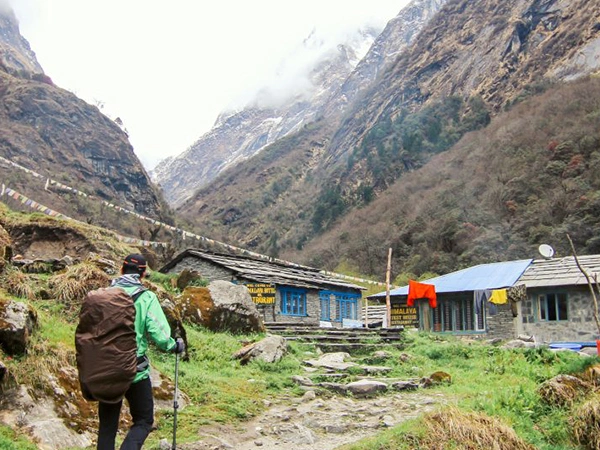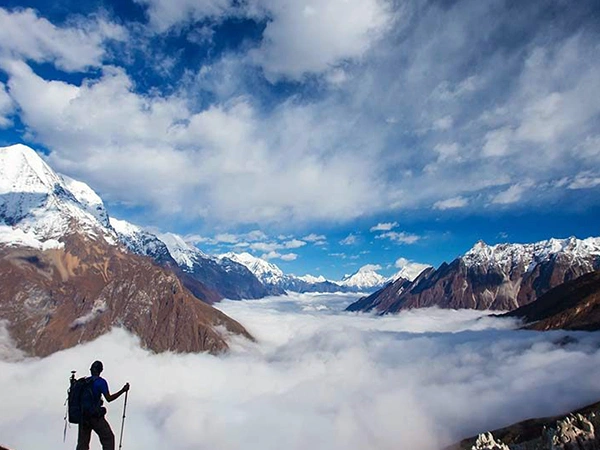The Everest Base Camp trek is one of the most iconic adventures in the world. Every year, thousands of trekkers fly into the mountains to reach the base of the world’s highest peak. The journey usually begins with a short flight to Lukla airport, known for its thrilling runway and dramatic mountain views.
But flying to Lukla is not always smooth. Lukla airport flights often face delays and cancellations due to sudden weather changes. In fact, Lukla is considered one of the world’s most dangerous airports because of its short runway, steep drop-offs, and unpredictable mountain weather. Many trekkers face long waits and missed itineraries. This can be frustrating, especially for those with limited travel time.
Because of these challenges, more travelers are now choosing to avoid the flight altogether. The Everest Base Camp trek by road offers a safer and more flexible option. It allows you to drive through scenic hills and begin your trek from the lower Everest region. This route is perfect for those seeking the EBC trek without flight, giving you a chance to enjoy more of Nepal’s culture and landscape before reaching the base of Everest.
Why Choose the Road to Everest Base Camp?
One of the main reasons trekkers choose the road to Everest Base Camp is reliability. Lukla flights are often delayed or canceled because of poor weather in the mountains. This makes trip planning difficult. On the other hand, the drive to Everest Base Camp is more stable. You won’t need to rely on clear skies or flight schedules. This makes your journey smoother and more predictable.
The road option is also more cost-effective. Flying to Lukla can be expensive, especially during the trekking season. When you choose the Everest Base Camp trek by road without flight, you save money on airfare. Driving may take longer, but it reduces flight-related costs and the risk of delays. It’s a smart choice for budget travelers who want to enjoy the trek without spending too much.
Another big benefit of driving is cultural immersion. The road passes through many small towns and villages that most trekkers never see. As you drive and walk through the lower hills, you meet locals and experience daily life in rural Nepal. The drive to Everest Base Camp lets you explore more of the country’s rich culture, scenic beauty, and remote landscapes than a quick flight ever could.
Route Options for the EBC Trek by Road
The Everest Base Camp trek by road offers more than one route. Depending on your preference for time, scenery, or cultural depth, you can choose between two rewarding options: the Salleri to Everest Base Camp trek or the historic Everest Base Camp trek via Jiri.
Salleri to Everest Base Camp Trek
The drive to Everest Base Camp through Salleri is the most popular flight-free option. It is ideal for those who want a reliable and scenic alternative to flying into Lukla.
Route Overview:
- Start with a drive from Kathmandu to Salleri (8–10 hours).
- Begin trekking from Salleri and join the classic Everest trail near Phakding.
Highlights:
- Pass through traditional Sherpa villages such as Kharikhola, Paiya, and Ringmo.
- Enjoy beautiful views of terraced hills, rivers, and rhododendron forests.
Duration:
- The full Salleri to Everest Base Camp trek takes around 12–14 days, including acclimatization stops.
Everest Base Camp Trek via Jiri
The Everest Base Camp trek via Jiri is perfect for trekkers seeking a historical and immersive route. It is longer but filled with rich landscapes and cultural encounters.
Historical Significance:
- This was the original route taken by Sir Edmund Hillary and Tenzing Norgay during their first successful Everest expedition in 1953.
Scenic Beauty:
- Travel through lush forests, rivers, and terraced farmlands.
- Cross several high passes and explore quiet mountain villages.
Duration:
- The Everest Base Camp trek via Jiri takes about 18–22 days, depending on your pace and rest days.
Both routes offer a beautiful and enriching drive to Everest Base Camp, with plenty of chances to engage with local culture and avoid the risks of air travel.
Best Time to Embark on the Road-Based EBC Trek
Choosing the right season can make your Everest Base Camp trek by road safer and more enjoyable. Here’s a breakdown:
Spring (March–May):
- Perfect for the EBC trek without flight.
- Offers clear mountain views and blooming rhododendrons.
- Ideal temperatures and longer daylight hours.
Also Read: Everest Base Camp Trek in March
Autumn (September–November):
- The most stable weather for trekking.
- Dry trails and excellent visibility.
- A great alternative to unreliable Lukla airport flights.
Also Read: Everest Base Camp Trek In September
Monsoon (June–August):
- Not recommended for the road to Everest Base Camp.
- Heavy rain may lead to landslides and poor trail conditions.
- Risky and uncomfortable for trekkers.
Also Read: Best Time To Go To Everest Base Camp
For the best experience, plan your EBC trek without flight in spring or autumn. These seasons offer safety, beauty, and comfort without the stress of flight cancellations.
Permits and Regulations for the Road to Everest Base Camp
If you’re planning to take the road to Everest Base Camp, whether via Salleri to Everest Base Camp trek or other routes, you’ll need a few important permits. These are required for all trekkers in the region.
- TIMS Card (Trekkers’ Information Management System):
This card is essential for all trekkers. It helps maintain safety records and ensures your trek is monitored for security. - Sagarmatha National Park Permit:
This permit is required to enter the national park, which encompasses the Everest region. It is essential for any trekking in this area. - Local Entry Permit:
If you’re trekking through routes like Salleri or Jiri, a local entry permit is required. This helps with managing tourism in these local areas.
It’s crucial to keep all permits with you during the trek. Permits will be checked along the way, and missing or expired documents can delay your journey or result in fines.
Also Read: Nepal Trekking Permits – Restricted Area Permits and Fees
Accommodation and Facilities on the Road-Based Everest Base Camp Trek
Along the road-based Everest Base Camp trek, you’ll find teahouses that offer basic yet comfortable accommodation. These teahouses are spread out across the trekking route, providing essential services to trekkers.
Teahouses:
Teahouses are the main form of accommodation. They are simple but cozy, offering a place to rest after a long day of trekking. Basic facilities such as a bed, blanket, and sometimes a heater are provided.
Meals:
Expect a variety of local dishes. Common meals include Dal Bhat (lentil soup with rice), noodles, and momos (dumplings). These are filling and provide the energy needed for the trek.
Connectivity:
Mobile networks are available in most key villages along the road-based Everest Base Camp trek, although they can be intermittent in remote areas. Limited Wi-Fi is also available in some teahouses, but it may be slow.
These facilities, while simple, ensure that trekkers are well-fed and rested for the challenging trek to Everest Base Camp.
Tips for a Successful Road-Based EBC Trek
Embarking on the EBC trek without flight and taking the road to Everest Base Camp requires adequate preparation and awareness. Here are some essential tips to ensure a smooth journey:
Physical Preparation:
While the Everest Base Camp trek via Jiri and Everest Base Camp trek by road routes do not involve flights, they do require extra physical effort. Expect to walk long distances over varied terrain. Train for endurance and stamina to manage the extended trekking days and the altitude.
Packing Essentials:
Make sure to pack wisely for your trek. Key essentials include:
- Layers: The weather can vary, so packing layered clothing will help you stay comfortable.
- Sleeping Bag: Bring a warm sleeping bag, as nights can get chilly.
- First Aid Kit: A basic first aid kit is essential in case of minor injuries or illnesses.
- Power Banks: Since charging facilities can be limited on the road to Everest Base Camp, a portable power bank is crucial to keep your devices charged.
Hiring Guides and Porters:
Especially for the Everest Base Camp trek via Jiri, it’s recommended to hire a guide and porters. The trek can be longer and more challenging, and local guides will help you navigate the route while porters carry your heavy bags, allowing you to focus on the trek itself.
Cultural Etiquette:
The villages along the road to Everest Base Camp are home to many Sherpa communities. Show respect for local customs and traditions. Simple gestures like greeting locals with a smile or “Namaste” can make a big difference and enhance your experience.
Conclusion
In conclusion, the Everest Base Camp trek by road is not only a scenic and flexible alternative but also a cost-effective way to experience the majestic Himalayas. It eliminates the unpredictability of Lukla flights while offering a more intimate connection with the culture and landscapes of Nepal.
If you’re looking for a richer Himalayan experience, consider the EBC trek without flight, whether you choose to start your adventure via Salleri or Jiri. This road-based trek offers the chance to immerse yourself in local villages and breathtaking views, making it a truly unique and memorable journey.
For more information and to book your Everest Base Camp trek by road, visit Himalayas On Foot or WhatsApp Surendra.
FAQs about Everest Base Camp Trek by Road
Is the road-based EBC trek suitable for beginners?
Yes, the road-based Everest Base Camp trek is suitable for beginners with basic fitness, but it’s important to train for endurance due to the extended walking.
How does the scenery compare to the traditional Lukla route?
The road to Everest Base Camp offers a different experience, with views of mountains, rivers, and traditional villages, giving a more immersive cultural experience compared to the Lukla route.
What are the transportation options from Kathmandu to Salleri or Jiri?
Buses and private vehicles are the main options. The drive takes 8–12 hours from Kathmandu to Salleri or Jiri, the starting points for the trek.
Are there any health risks associated with the road routes?
While the road to Everest Base Camp avoids flight risks, altitude sickness is still a concern. Acclimatization, hydration, and rest are essential to stay healthy.
What is the distance from Kathmandu to Everest Base Camp by road?
The distance from Kathmandu to Salleri or Jiri is around 270–300 km by road. From there, it’s about 130 km of trekking round trip to Everest Base Camp.
Can I go from Kathmandu to Everest Base Camp by road?
Yes, you can drive to Salleri or Jiri, then begin the Everest Base Camp trek by road on foot.
How difficult is the Everest Base Camp trek by road?
The trek is moderately challenging, with longer walking days than the Lukla route. However, it provides better acclimatization and cultural exposure.
Is there a jeep service to Everest Base Camp?
You can take a jeep to Salleri or Jiri, but you’ll need to trek from there. There’s no direct jeep access to Everest Base Camp.
Can you drive directly to Everest Base Camp?
No, you can’t. The final stretch must be done on foot due to the rugged, mountainous terrain beyond Salleri or Jiri.



![Best Time to Do the Tsum Valley Trek in Nepal [With Trekking Tips]](https://himalayasonfoot.com/uploads/blog/best-time-to-do-the-tsum-valley-trek-in-nepal.webp)

